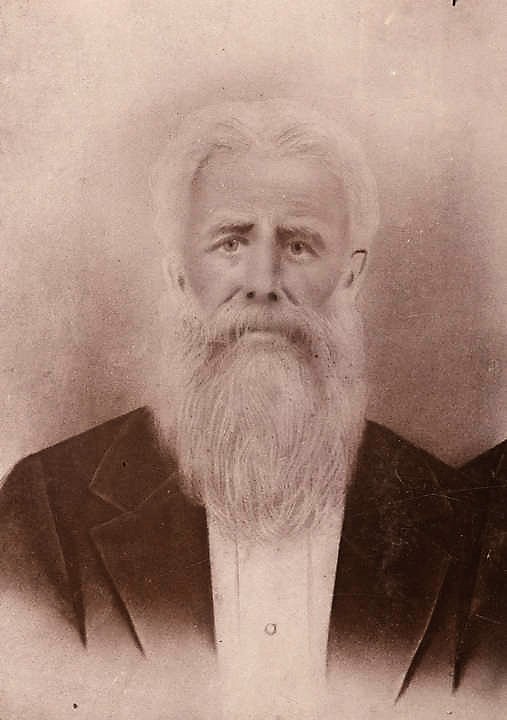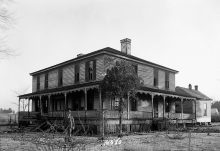Biographies of the Delegates to the Alabama Secession Convention
Part XIV 1
Henry C. Sanford
Cherokee County

A son of Hezekiah P. and Priscilla Sanford, Henry C. was born on May 20, 1808, in Greenville District, South Carolina and died on May 28, 1888, in Cherokee County, Alabama. Attending school only ten months, Sanford was forced to educate himself through diligent study and reading. He read law without intending to practice. He went to East Tennessee in 1832; to Turkeytown, Cherokee County, Alabama; to Gaylesville; back to East Tennessee where he taught school for ten years; then returned to Cherokee County, Alabama. In 1853-57 he represented Cherokee County in the legislature and was a member of the Constitutional Convention of 1865. During the years he was teaching in East Tennessee Sanford became a Methodist minister. He was first married to Mary C. Long on February 18, 1829, Harriet White the second but the name of the third wife is not known. Children by his first wife were Lucila A., Luvina E., Lucina S., Leila P., L. H., Looney L., Luviney S. and Lumintia H.; the second wife bore Russell and Henry B.
NOTE ADDITIONAL INFORMATION
From History of Alabama and Dictionary of Alabama Biography, Volume 4 By Thomas McAdory Owen, Marie Bankhead Owen, S. J. Clarke Publishing Company 1921
Sanford was the son of Hezekiah P. and Priscilla (Chambers) Sanford, a soldier in the War of 1812, grandson of Thomas P. Sanford, and wife, a Miss Rutledge, the former a Revolutionary soldier, and of Phillip Chambers, and wife, a Miss Suggs. He attended school only ten months, but having a vigorous mind instructed himself and in time became proficient in arithmetic and algebra and acquired a fair scholarship in Greek and Latin. He also read law but with no intention of entering the practice.
About 1833 he went to East Tennessee where he remained for some time, then removed to Turkeytown, Cherokee County, where he merchandised. He next moved to Gaylesville, but after a short stay, he returned to East Tennessee where he lived ten years, engaged in teaching school.
During these years he also became a Methodist minister. His last move was back to Cherokee County, which he represented in the Legislature 1853-1857. He was a member of the Secession convention, 1861, and was opposed to the State’s withdrawal from the Union. He was also a member of the Constitutional Convention of 1866. Married: (1) February 18, 1829, to Mary C. Long; (2) Harriet White; (3) Name unknown. Children: by first wife: 1. Lucila S., m. Mr. Thompson; 2. Luvina E., 3. Lumina A., m. Mr. Norton; 4. Lucina S., m. Mr. Erkson; 5. Leila P. m. Mr. Lyboss; 6. L. H.; 7. Looney L.; 8. and 9. twins, Luviney S. and Lumintia H. m. Mr. Hudson; by the second wife: 10. Russell; 11. Henry B.; no children by the third wife. Last residence: Cherokee County.
Click to see all books by Donna R Causey
Charles Christopher Sheets/Sheats
Winston County
Son of William W. and Mary Sheets, Charles Christopher Sheets was born in Walker County, Alabama, April 10, 1839. He received a good education at the Somerville Academy in Morgan County and began to teach school at the age of eighteen. He was one of the leaders of more than 2500 people who met at Looney’s Tavern in Winston County for the purpose of preventing the secession of Alabama by withdrawing Winston County from the state but the movement failed. A member of the legislature in 1862, he was expelled from that body, arraigned, indicted and imprisoned for treason to the Confederacy. In 1863 General Thomas of the Federal. Army ordered General Crook at Huntsville to arrest and imprison William M. McDowell as a hostage for Sheets. Nothing more was done with Sheets, but he was held in duress until the end of the war. He was a member of the Constitutional Convention of 1865, and a candidate for Congress from the sixth district the same year. He was a Grant elector in 1868 and the following year was appointed United States Consul to Denmark. Remaining in Denmark for three years, he returned home in time to be a delegate to the Republican Convention at Philadelphia in 1872, which nominated Grant for the second term. The same year he was elected to Congress from the state at large by a majority of 10,000 over Alpheus Baker but was defeated two years later. He was an auditor for the Post Office Department from 1875 to 1877, when he resigned to become appraiser of merchandise for the Port of Mobile. One year later Sheets was appointed Assistant Collector of Internal Revenue in Alabama and he held this position until the inauguration of Cleveland in 1885. On January 27, 1887, he was married to Mrs. Mary Anderson, nee Dickson, a woman of English ancestry. (findagrave.com memorial 7420189)
NOTE ADDITIONAL INFORMATION
From History of Alabama and Dictionary of Alabama Biography, Volume 4 By Thomas McAdory Owen, Marie Bankhead Owen, S. J. Clarke Publishing Company 1921
SHEATS, CHARLES CHRISTOPHER, U. S. Commissioner, consul to Denmark, member of Congress, member State Legislature and the Constitutional Convention, 1865, was born April 10, 1839, in Walker County; son of William W. and Mary (Garner) Sheats, the former a native of Wilkes County, Ga., born October 22, 1809, and removed to Walker County, the latter a native of Tennessee, born in 1811; grandson of Archibald and Amanda (Gibson) Sheats, natives of Georgia who removed to Lawrence County in 1822, and of Jacob and Mary (Hunter) Garner, the former a soldier in the Texas revolution, and the Mexican War.
Mr. Sheats was reared on a farm, received a good education at Somerville academy in Morgan County, and began teaching school at eighteen years of age. He represented Winston County in the session of 1861 and strenuously opposed the secession of the State. At the next term of the Legislature, 1862, he was expelled from the house on account of alleged disloyalty to the Confederate government. He was arraigned, indicted and imprisoned for treason. The Federal general, Thomas, in December 1863, retaliated by ordering Gen. Crook, at Huntsville to arrest William McDowell and confine him in jail as a hostage for Christopher Sheats. Nothing further was done with Mr. Sheats except to hold him in duress until the end of the war.
In September 1865, he was elected a member of the Constitutional Convention for Winston County. In the same year, he was a candidate for Congress from the Sixth District. In 1868, he was a Grant elector and the next year was appointed U. S. consul to Denmark where he remained three years. In 1872 he was a delegate to the Philadelphia convention, which nominated Grant for his second term, and the same year was elected to Congress from that state at large by a majority of the thousand over Gen. Alpheus Baker. In 1874, he was an unsuccessful candidate for Congress. In 1875, he was the sixth auditor of the United States Treasury for the post office department, which he held until 1877, when he resigned and was appointed appraiser of merchandise for the port of Mobile. He served in this capacity until 1878, when he was appointed assistant collector of internal revenue for the State of Alabama and served until the inauguration of Cleveland. Married: January 27, 1887, to Mrs. Mary Anderson, nee Dickson, a lady of English ancestry. Last Residence: Mobile.
James Lawrence Sheffield
Marshall County
A colonel in the Forty-eighth Alabama Infantry Regiment of the Confederate Army and a state legislator from Marshall County, James Lawrence Sheffield was born December 5, 1819, in Huntsville, Alabama, and died in 1892 at Montgomery, Alabama. The son of Nicholas and Mary Sheffield, he was educated in the common schools of his native town. In 1837 Sheffield went to Claysville, Marshall County, Alabama, and clerked in a store for four years; he was a deputy sheriff at Claysville from 1844 to 1847. Sheffield represented Marshall County in the state legislature in 1855 and 1857; the Constitutional Convention of 1865; and was state senator from Marshall, DeKalb and Jackson counties in 1886. Entering the Confederate Army in 1861 as a lieutenant of Company K of the Ninth Alabama Infantry Regiment, he was soon promoted to captain. In 1862 he raised the Forty-eighth Alabama Regiment at his own personal expense of $57,000; part of the money in repayment was deposited to his credit in a Richmond bank by the Confederate Government but he lost it when that city surrendered. He was unanimously elected colonel of the regiment, and it left for Richmond without delay. Before the war Sheffield engaged in merchandising and planting; after the war, he operated stores at several places in Marshall County. Retiring from mercantile enterprises in 1884, he became a clerk at the state department of education and was employed by the Western of Alabama Railroad Company at the time of his death. He was a Mason. On June 21, 1884, he was married to Mary Ann, the widow of O. D. Street, who was the daughter of Thomas and Rebecca Atkins. Their children were Mary, Andrew Moore, James Bradley, Rebecca, Lucinda and William Smith. (Findagrave.com memorial 30296229)
NOTE ADDITIONAL INFORMATION
From History of Alabama and Dictionary of Alabama Biography, Volume 4 By Thomas McAdory Owen, Marie Bankhead Owen, S. J. Clarke Publishing Company 1921
James Lawrence Sheffield, colonel 48th Alabama Infantry regiment, C. S. Army, a member of Secession Convention, and State Senator, was born December 5, 1819, in Huntsville, and died July 2, 1892, in Montgomery; son of Nicholas and Mary (Martin) Sheffield respectively of Virginia and North Carolina, and who came to Huntsville in 1818, a carriage-maker. He was educated in the common schools of Madison County and in 1837 removed to Marshall County where he clerked in a store for four years at Claysville. Some years later he owned a well-stocked plantation, operated by negro slaves. After the War of Secession, he began merchandising, first at Guntersville and later at Warrenton, but discontinued this business in 1884. In 1886 he was a clerk in the State Department of Education and at the time of his death was in the employ of the Western railway of Alabama. He was a deputy sheriff at Claysville from 1844-47; member of the Constitutional Conventions of 1861 and 1865; member of the Secession convention in 1860, and vigorously opposed secession, but when the ordinance was passed he signed it by instruction of his constituents and became at once one of the most zealous upholders of the Confederate cause.
He represented Marshall County in the lower house of the legislature in 1855, 1857 and 1865, and as State Senator in 1886, represented Marshall, Dekalb and Jackson Counties. While a member of the Senate in 1886, he took an active stand in favor of an appropriation for the building of the Confederate monument in Montgomery and success of the movement was largely due to his influence. He entered the Confederate service in 1861 as lieutenant of Co. K. 9th Alabama Infantry regiment and was in time promoted to a captaincy. In April 1862, he returned home with authority to raise a regiment. Within one month he raised the 48th Alabama Infantry regiment at his own personal expense, fifty-seven thousand dollars in money. A part of this sum was afterward returned to him by the Confederate government, but as it was deposited in a Richmond bank, he lost the entire amount when that city surrendered. He was unanimously elected colonel of this regiment which he led to Richmond without delay. He commanded Taliaferro’s brigade for about eight months and led Law’s brigade at Gettysburg and Chickamauga. At this last battle, he was so injured by the concussion of a shell that by the advice of a board of surgeons he retired from the army, but he never ceased to labor for the Confederate cause. Col. Sheffield was a Democrat of the strongest convictions. He supported Douglas in the presidential campaign of 1860 and made numerous speeches in favor of that ticket.
After the war, he was a most bitter opponent of the fifteenth amendment and after reconstruction, in spite of Federal militarism, he fearlessly canvassed the counties of north Alabama and everywhere made vehement speeches in behalf of the Democratic party. He was a member of the Masonic lodge at Warrenton; was many times its worshipful master, and on Masonic celebrations was often the orator of the day. Married: June 21, 1844, at Warrenton, to Mary Ann, widow of Rev. Oliver Day Street, and daughter of Thomas and Rebecca (Tate) Atkins, grand-daughter of Abner Tate, a native of Kentucky, who removed to Hazel Green about 1809, in 1814 was appointed a member of the orphans’ court of Madison County of which Leroy Pope and Dr. David Monroe were at the same time members. Children: 1. Mary m. Creed L. Taylor, at Guntersville; 2. Andrew Moore, a daughter, unmarried, Tuscaloosa; 3. James Bradley, Lauderdale; 4. Rebecca, dec. (by 1921) m. Alonzo S. Mitchell, Corsicana, Texas; 5. Lucinda, dec. (by 1921) m. John H. Fennell; 6. William Smith, Santa Anna, Calif. Last Residence; Montgomery.
George David Shortridge
Shelby County
George David Shortridge was born in 1814 at Mt. Sterling, Kentucky, and died in Montevallo, Alabama, in July 1870. A son of Judge EH and Leah Shortridge, he was educated in the schools of Tuscaloosa, and graduated from the University of Alabama in 1833 with a Phi Beta Kappa key. At a subsequent date the University of Alabama conferred an A.M. degree upon him. Admitted to the bar in 1835, Shortridge removed to Montgomery to practice his profession. He soon became county solicitor, mayor and a director of the state bank. He returned to Montevallo in 1838 and was circuit judge for ten years. Shortridge was candidate for Governor on the Know-Nothing ticket but was defeated. An author of some local renown, he frequently contributed to the Literary Messenger and De Bow’s Review. He was a Baptist and an Odd Fellow. In 1836 he married Elizabeth King of Montevallo, and their children were George David, Louisa, Eli, Frank Forester, Lelia and William Webb. (Findagrave.com memorial 59311652)
NOTE ADDITIONAL INFORMATION
From History of Alabama and Dictionary of Alabama Biography, Volume 4 By Thomas McAdory Owen, Marie Bankhead Owen, S. J. Clarke publishing Company 1921
SHORTRIDGE, GEORGE DAVID, mayor, county solicitor and circuit judge, was born in 1814, in Mt. Sterling, Ky., and died July 1. 1870, in Montevallo, Shelby County; son of Judge Eli and Leah (Howell) Shortridge. His father Eli, was born in 1794 in Paris Ky, and died July 20, in Talladega where he is buried. He was a lawyer in Tuscaloosa and member of the State Legislature, and Justice of the Alabama Supreme Court. His mother, Leah (Howell) Shortridge was from the Howard family of Virginia and Georgia.
George David Shortridge was educated in the schools of Tuscaloosa; graduated from the University of Alabama, 1833, the degree of A . M. being conferred later; studied law and admitted to the
bar, 1835. He removed to Montgomery; was appointed county solicitor; elected mayor of the city, and a director in the State bank. He removed to Montevallo and in 1838 was elected circuit judge and served ten years. He was nominated for governor of Alabama on the American or Know-nothing ticket, but was defeated; was a member of the Secession convention, 1861. Author: contributed to the” Southern literary messenger, and De Bow’s review. He was a “Know-nothing” but changed to the Democratic party; was a Secessionist; an Odd Fellow; and a Baptist. Married: in 1836, in Montevallo, to Elizabeth, daughter of Edmund and Nancy (Reagan) King, of Montevallo. Children: 1. George David, Jr., m. Victoria Echols; 2. Louisa, m. Judge Reuben Gains; 3. Eli, Confederate soldier, killed at the battle of Seven Pines; 4. Frank Forester, Confederate soldier, lieutenant, killed at Atlanta; 5. Leila, m. W. J. Sedberry; 6. William Webb, of Birmingham. Last residence: Montevallo.
Joseph Silver
Baldwin County
One of ten children, Joseph Silver was born March 14, 1818, at Dublin, Harford County, Maryland and died at Montgomery Hill, now Tensaw, Baldwin County, Alabama, June 30, 1869. His father placed him under a Dr. Davis to study medicine, but, after six months, he went to Booneboro, Washington County, to continue his studies under Dr William Whiteford. Because his inclinations were mechanical instead of medical, Silver abandoned the study of medicine and went to Philadelphia. He then went to Louisville, New Orleans and Mobile. Silver was employed by a contractor in Mobile but subsequently returned to New Orleans and bought an interest in the John T. Donald and Company, a form operating as cotton commissioners. Soon after 1840 Silver sold his interest in John T. Donald and Company and moved to Montgomery Hill. From 1840 to 1865 he acquired more than 6000 acres of land which was valued at $30,000; his mills were worth $4000. In addition to being a planter and a large landowner, Silver was a member of the firm of Silver, Wragg and Company of Mobile. He was a Presbyterian. In 1844 he was married to Martha Hodgens Booth of Montgomery Hill.
M. G. Slaughter
Talladega County
No information available for sketch.
This could be M. G. Slaughter —- Company C -(Captain M. G. Slaughter’s company) 5th Battalion, Hilliard’s Legion, Alabama Cavalry.
1 Transcribed from The Alabama Historical Quarterly, Vol. 03, Nos. 03 & 04, Fall and Winter Issue 1941
Have you heard excessive brain labor causes baldness or the cure for wrinkles is a tepid bath in bran?
Do you want to know Thomas Jefferson’s recipe for Vinegar of the Four Thieves or how to make Ox Tail Soup?
Have you ever had ‘blueberry pickles’, ‘batallia pie’ or ‘snow birds’? You will learn all this and more in “Vinegar of the Four Thieves.”
Our ancestors had to be resilient when they faced obstacles in daily life, from dealing with pests, medical emergencies, caring for clothing and cleaning shortcuts. Almost everything they used in daily life was homemade. Some ideas were great but some were very strange.





